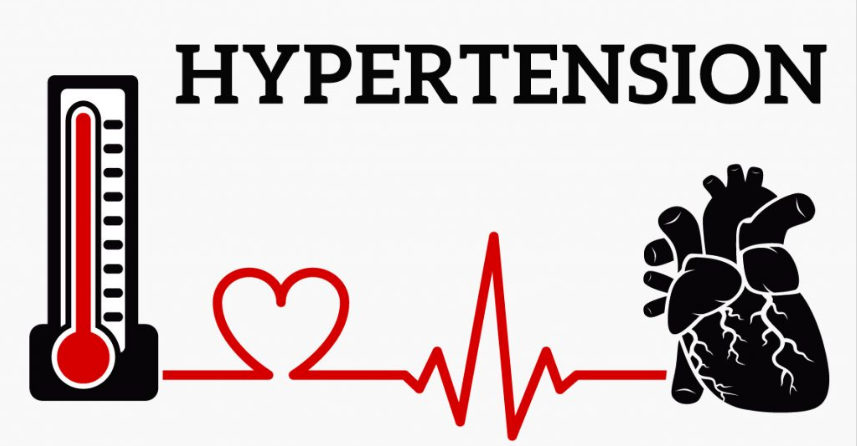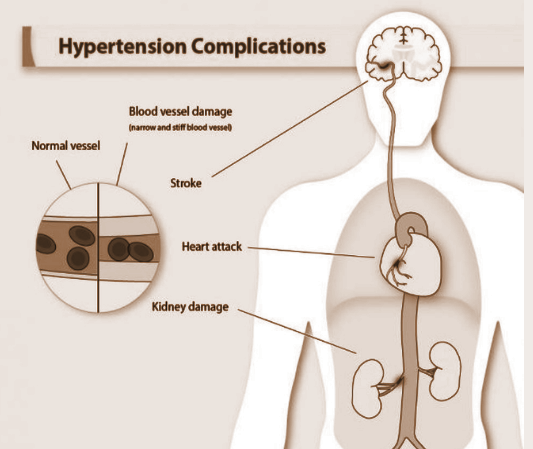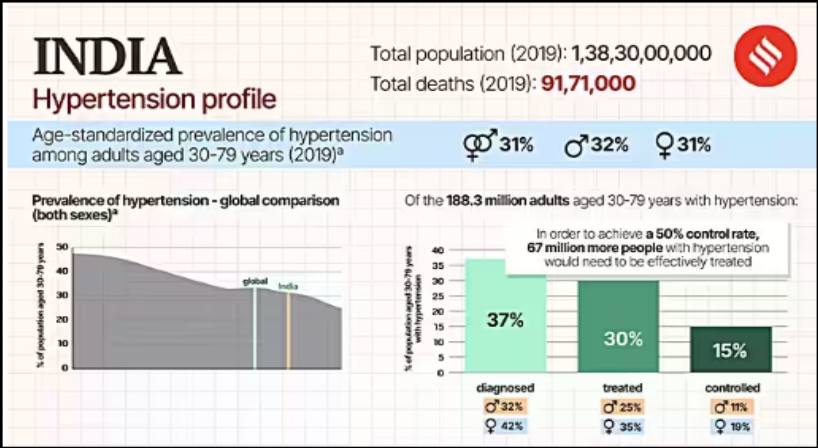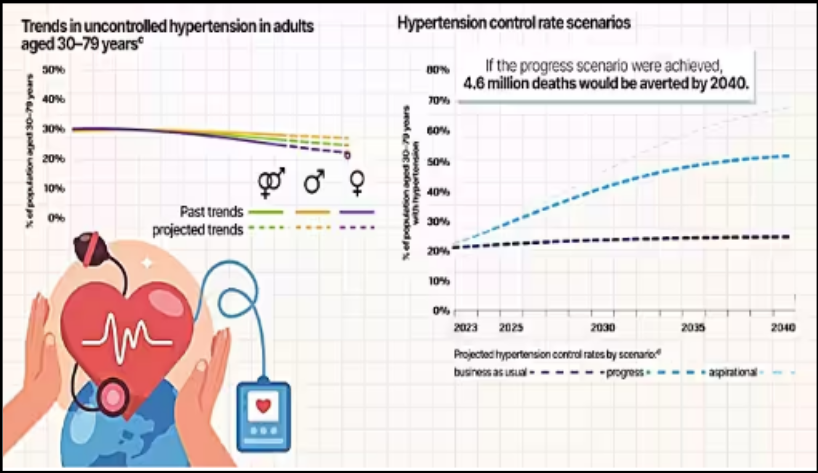
GS 3 - Polity
Why in the news?
The World Health Organization (WHO) has issued its first-ever report on the global effects of high blood pressure. According to this report, high blood pressure impacts one out of every three adults on a global scale.
About hypertension
- This is a health condition where the pressure in your arteries stays high for a long time. It is commonly known as "high blood pressure" among individuals.
- Blood pressure is usually represented by two numbers: one when the heart beats (systolic) and the other when the heart is resting (diastolic).
- Eating healthily, quitting smoking, and exercising more can lower your blood pressure.
|
Hypertension is the most important risk factor for death and disability in India, according to a paper in The Lancet, regional health (South-east Asia), published late last year.
|
Factors that raise the likelihood of developing high blood pressure comprise:
- being overweight or obese
- not being physically active
- high-salt diet
- older age
- genetics
- drinking too much alcohol
Four stages of the Hypertension
- Elevated blood pressure levels between 120-129/less than 80
- Hypertension stage 1 is 130-139/80-89 mmHg
- Hypertension stage 2 is 140/90 mmHg or more
- Hypertensive crisis is higher than 180/120 or higher

|
Key Findings of the Report:
1. Global High Blood Pressure Statistics:
- Approximately 80% of individuals with high blood pressure do not receive proper treatment.
- Expanding healthcare access globally could prevent 76 million deaths between 2023 and 2050.
- High blood pressure is defined as having a blood pressure reading of 140/90 millimeters of mercury (mmHg) or higher or taking medication for it.
- The global number of people with high blood pressure increased from 650 million to 1.3 billion between 1990 and 2019.
- Nearly half of all individuals with high blood pressure worldwide are unaware of their condition.
2. Key Findings About India:
- High blood pressure is the leading cause of health problems and death in India.
- Only 37% of Indians with hypertension are diagnosed, and a mere 30% receive treatment.
- A mere 15% of those with hypertension in India have their condition properly controlled.
- Approximately 52% of heart-related deaths in India, such as heart attacks, are attributed to high blood pressure.
- The primary factors contributing to high blood pressure in India include excessive salt consumption, smoking (28%), obesity, alcohol consumption, and lack of physical activity (34%).
- According to the National Family Health Survey (NFHS-5) conducted from 2016 to 2020, 24% of men and 21% of women in India had high blood pressure, marking an increase from 19% and 17%, respectively, in the previous survey (2015-16).
This organization separates the global findings from those specific to India, making it easier to understand the key points related to each aspect of the report.

Trend of Hypertension in Adults

|
Government Steps in India to Address Hypertension:
- Hypertension Control Initiative Programme:
- The Hypertension Control Initiative Programme operates under the National Health Mission in India.
- It has gained recognition for its positive impact on the country's primary healthcare system.
- The Indian Hypertension Control Initiative (IHCI) is a five-year effort involving multiple stakeholders, including the Ministry of Health & Family Welfare, the Indian Council of Medical Research, State Governments, and WHO-India.
- Program Launch and Coverage:
- As of December 2021, IHCI had been launched in 101 districts across 19 states in India.
- IHCI has successfully enrolled over 2 million patients in more than 13,000 healthcare facilities.
- Enrollment Statistics in Phase I Districts:
- In the initial 26 Phase I districts where IHCI was implemented, approximately 22% of the estimated total number of individuals with hypertension in those districts were enrolled.
These government initiatives demonstrate a concerted effort to address hypertension in India through a collaborative approach involving various agencies and stakeholders, with a focus on expanding access to healthcare and improving hypertension control.
|
Prominent Drugs for Hypertension
Medicines for high blood pressure include:
- Water Pills (Diuretics): These drugs remove sodium and water from the body and are often the first choice for hypertension. Types include thiazide, loop, and potassium-sparing diuretics like chlorthalidone and hydrochlorothiazide.
- Angiotensin-Converting Enzyme (ACE) Inhibitors: They relax blood vessels by blocking the formation of a chemical that narrows them. Examples include lisinopril, benazepril, and captopril.
- Angiotensin II Receptor Blockers (ARBs): These drugs also relax blood vessels but block the action of a natural chemical. Examples include candesartan and losartan.
- Calcium Channel Blockers: These medications relax blood vessel muscles and some slow heart rate. Examples include amlodipine and diltiazem.
- Alpha Blockers: Reduce nerve signals to blood vessels, lowering the effects of chemicals that narrow them. Examples include doxazosin and prazosin.
- Alpha-Beta Blockers: Block nerve signals to blood vessels and slow the heartbeat, reducing blood volume. Examples include carvedilol and labetalol.
- Beta Blockers: Reduce heart workload and widen blood vessels. Examples include atenolol and metoprolol, often used in combination with other drugs.
- Aldosterone Antagonists: Used for resistant hypertension to block a chemical causing salt and fluid buildup. Examples are spironolactone and eplerenone.
- Renin Inhibitors: Medication like aliskiren slows renin production, a kidney enzyme raising blood pressure.
- Vasodilators: Prevent artery muscles from tightening, preventing narrowing. Examples include hydralazine and minoxidil.
- Central-Acting Agents: These drugs stop the brain from increasing heart rate and narrowing blood vessels. Examples include clonidine, guanfacine, and methyldopa.
|




